-
 Bando Mitsugorō III as Lady Iwafuji and Nakamura Matsue III as Lady Onoe, 1821.「局岩ふじ 坂東三津五郎」(三代)、「中老尾上 中村松江」(三代) in kabuki play Kagamiyama Kokyô no Nishikie [鏡山旧錦繪] (Mirror mountain: A women’s treasury of loyalty); author: Yô Yôdai. Artist: Shunkōsai Hokushū (春好斎 北洲), who is also known as Shunkō IV, active from about 1802 to 1832. Actors: Bandō Mitsugorō III [三代目 坂東 三津五郎] (Japanese, 1775 – 1831); other names: Bandō Minosuke I, Morita Kanjirô II, Bandō Mitahachi I, Bandō Minosuke I, Bandō Mitahachi I. Nakamura Matsue III [三代目中村松江] (Japanese, 1786-1855); other names: Nakamura Sankō I, Nakamura Tomijūrō II, Ichikawa Kumatarō. Year: 1821 (Bunsei 4), 1st month. Publisher: Wataya Kihei (Wataki) (Japanese, fl. c. 1809 – 1885) Signed Shunkôsai Hokushû ga 春好斎北洲画. MFA Accession № 11.35375. MFA description: "Play: Keisei Kagamiyama (Mirror Mountain, a Courtesan Play). Theatre: Kado けいせい双鏡山(けいせいかがみやま)角. Ref.: [LIB-1193.2013] Leiter. Kabuki Encyclopedia, p. 156; [LIB-0879-2.2015] Kabuki plays on stage (vol. 2): 1773-1799, pp. 172-212.
Bando Mitsugorō III as Lady Iwafuji and Nakamura Matsue III as Lady Onoe, 1821.「局岩ふじ 坂東三津五郎」(三代)、「中老尾上 中村松江」(三代) in kabuki play Kagamiyama Kokyô no Nishikie [鏡山旧錦繪] (Mirror mountain: A women’s treasury of loyalty); author: Yô Yôdai. Artist: Shunkōsai Hokushū (春好斎 北洲), who is also known as Shunkō IV, active from about 1802 to 1832. Actors: Bandō Mitsugorō III [三代目 坂東 三津五郎] (Japanese, 1775 – 1831); other names: Bandō Minosuke I, Morita Kanjirô II, Bandō Mitahachi I, Bandō Minosuke I, Bandō Mitahachi I. Nakamura Matsue III [三代目中村松江] (Japanese, 1786-1855); other names: Nakamura Sankō I, Nakamura Tomijūrō II, Ichikawa Kumatarō. Year: 1821 (Bunsei 4), 1st month. Publisher: Wataya Kihei (Wataki) (Japanese, fl. c. 1809 – 1885) Signed Shunkôsai Hokushû ga 春好斎北洲画. MFA Accession № 11.35375. MFA description: "Play: Keisei Kagamiyama (Mirror Mountain, a Courtesan Play). Theatre: Kado けいせい双鏡山(けいせいかがみやま)角. Ref.: [LIB-1193.2013] Leiter. Kabuki Encyclopedia, p. 156; [LIB-0879-2.2015] Kabuki plays on stage (vol. 2): 1773-1799, pp. 172-212. -

Iron tsuba of oval form with a shakudō fukurin and rough surface decorated by low relief carving and brass inlay with a centipede emerging from under the rock on both sides.
Edo period.Size: 78.9 x 73.6 x 3.8 mm
Unsigned. However, this tsuba may be (though with reservation) attributed to Misumi Kōji school. There is some information regarding this master(s) in Tsuba. An aesthetic study by Kazutaro Torigoye and Robert E. Haynes (from the Tsuba Geijutsu-kō of Kazataro Torigoye. Edited and published by Alan L. Harvie for the Nothern California Japanese Sword Club, 1994-1997) on pages 163-4, though I was not able to locate the tsuba in the original publication. Possibly, this fragment of the book was added by Robert Haynes. Markus Sesko speculates about Misumi in his The Japanese toso-kinko Schools.// Lulu Inc., 2012 on pages 374-5: "Misumi Kōjo Tsuba. Iron plate, elliptical shape, shakudō takabori suemon, yamagane fukurin. Centipede." But of course, visual similarity does not prove anything. I was not able to find any traces of signature or a triangle on the seppa-dai.
Misumi Kōji Tsuba on p. 163.
-
 Artist: Utagawa Kunisada [歌川 国貞], a.k.a. Utagawa Toyokuni III [三代 歌川 豊国] (Japanese, 1786 – 1865). Signed: Toyokuni ga [豊国 画] in a red toshidama cartouche Block carver: Yokokawa Takejirō [横川竹二郎] (Japanese, fl. 1845 – 1863), seal: 彫竹 – Hori Take. Publisher: Ibaya Senzaburō [伊場屋仙三郎] (Japanese, fl. c. 1845 – 1847). Combined date and kiwame seal: Ansei 5 (II-XII/1858). Size: Untrimmed fan print (uchiwa-e), 300 x 232 mm.
Artist: Utagawa Kunisada [歌川 国貞], a.k.a. Utagawa Toyokuni III [三代 歌川 豊国] (Japanese, 1786 – 1865). Signed: Toyokuni ga [豊国 画] in a red toshidama cartouche Block carver: Yokokawa Takejirō [横川竹二郎] (Japanese, fl. 1845 – 1863), seal: 彫竹 – Hori Take. Publisher: Ibaya Senzaburō [伊場屋仙三郎] (Japanese, fl. c. 1845 – 1847). Combined date and kiwame seal: Ansei 5 (II-XII/1858). Size: Untrimmed fan print (uchiwa-e), 300 x 232 mm.A young woman adjusting her hairpin on a balcony during the Tanabata festival, as inscribed on the white folding fan: [七夕] (Tanabata).
Inscription on the blue book (print title): Early autumn [はつ秋や] (hatsu akiya), inscription on the purple book (series title): Short love songs, second volume [端唄の意 二編] (Hauta no kokoro nihen). According to Marks (2010), Hauta no kokoro nihen series of fan prints was published by Ibaya in 1858 (p. 267|P6871).
The series refers to love songs of a certain type popular in late Edo. They were performed with the accompaniment of a shamisen, “Seven herbs of autumn, the song of the insects is not heard; the bodies of lightning bugs are burnt, and the precious writings of love are getting thinner like the song of the insects as I am waiting for you. So, on an early autumn evening, I spot the glitter of a lightning bug that lingered among the autumn grasses, and while listening to the pine cricket, I am singing with my heart troubled by love". [Tokyo National Museum; translation provided by Elena Varshavsky].Tanabata [たなばた] or [七夕] – meaning "Evening of the seventh", also known as the Star Festival [星祭] (Hoshi matsuri) – is a Japanese festival originating from the Chinese Qixi Festival. One popular Tanabata custom is to write one's wishes on a piece of paper and hang that piece of paper on a specially erected bamboo tree, in the hope that the wishes become true.
-
 Artist: Utagawa Kunisada [歌川 国貞], a.k.a. Utagawa Toyokuni III [三代 歌川 豊国] (Japanese, 1786 – 1865). An untrimmed fan print titled Fuji Tsukuba aiaigasa, shows the actors Nakamura Shikan II [二代目中村芝翫] and the onnagata actor Iwai Kumesaburō II [岩井粂三郎] sharing an umbrella against the snow. Tsukuba, about 50 kilometres from Edo, was an area where both Fuji and Mount Tsukuba could be viewed together. Mount Fuji being the female and Mount Tsukuba the male. An aizuri-e background (common to all the designs in this set). A play on images and words. Actors: Nakamura Utaemon IV [中村歌右衛門] (Japanese, 1796 – 1852); other names: Nakamura Shikan II [二代目中村芝翫], Nakamura Tsurusuke I, Nakamura Tōtarō. Iwai Hanshirō VI [[岩井半四郎] (Japanese, 1799 – 1836); other names: Iwai Hanshirō VI, Iwai Kumesaburō II [岩井粂三郎], Iwai Hisajirō I, Baiga (poetry name), Shūka (poetry name). Publisher: Ibaya Senzaburo [伊場屋仙三郎] (Japanese, fl. c. 1845 – 1847). Date: circa 1832. Signed: Kōchōrō Kunisada ga in a red double-gourd cartouche. From the series of fan prints:
Artist: Utagawa Kunisada [歌川 国貞], a.k.a. Utagawa Toyokuni III [三代 歌川 豊国] (Japanese, 1786 – 1865). An untrimmed fan print titled Fuji Tsukuba aiaigasa, shows the actors Nakamura Shikan II [二代目中村芝翫] and the onnagata actor Iwai Kumesaburō II [岩井粂三郎] sharing an umbrella against the snow. Tsukuba, about 50 kilometres from Edo, was an area where both Fuji and Mount Tsukuba could be viewed together. Mount Fuji being the female and Mount Tsukuba the male. An aizuri-e background (common to all the designs in this set). A play on images and words. Actors: Nakamura Utaemon IV [中村歌右衛門] (Japanese, 1796 – 1852); other names: Nakamura Shikan II [二代目中村芝翫], Nakamura Tsurusuke I, Nakamura Tōtarō. Iwai Hanshirō VI [[岩井半四郎] (Japanese, 1799 – 1836); other names: Iwai Hanshirō VI, Iwai Kumesaburō II [岩井粂三郎], Iwai Hisajirō I, Baiga (poetry name), Shūka (poetry name). Publisher: Ibaya Senzaburo [伊場屋仙三郎] (Japanese, fl. c. 1845 – 1847). Date: circa 1832. Signed: Kōchōrō Kunisada ga in a red double-gourd cartouche. From the series of fan prints:
Two more prints from the series 'Fuji and Tsukuba sharing an umbrella' (Fuji Tsukuba aiaigasa), not in this Collection:
SVJP-0342.2021

Kabuki actors Onoe Kikugorō III and Iwai Kumesaburo II. Year: c. 1832; Publisher: No seal; Signed: Kōchōrō Kunisada ga From Kunisada Project. 
Kabuki actors Bandō Minosuke II and Iwai Shijaku I. Year: c. 1832; Publisher: No seal; Signed: Kōchōrō Kunisada ga From Kunisada Project. -
 Artist: Utagawa Kunisada [歌川 国貞], a.k.a. Utagawa Toyokuni III [三代 歌川 豊国] (Japanese, 1786 – 1865). Signed: Toyokuni ga [豊国 画] in a red toshidama cartouche Block carver: Yokokawa Takejirō [横川竹二郎] (Japanese, fl. 1845 – 1863); seal: Hori Take [彫竹]. Publisher: Iseya Magobei [伊勢屋孫兵衛] (Japanese, fl. c. 1794 – 1868); seal: Hanmoto, Masu [板元, 益] (Marks 19-039 | 150d). Date-aratame seal: Ansei 2 (1855). Title: Time in Fukagawa, Iyo Province (Fukagawa Iyo setsu). Ref.: [LIB-3008.2022] Andreas Marks. Japanese woodblock prints: Artists, publishers and masterworks, 1680 – 1900. — Tuttle Publishing, 2010; p. 221. –> 1855 Kunisada. "Iyo Province-time at Fukagawa" (Fukagawa Iyo setsu). Fan print. Japan Ukiyo-e Museum, Matsumoto.
Artist: Utagawa Kunisada [歌川 国貞], a.k.a. Utagawa Toyokuni III [三代 歌川 豊国] (Japanese, 1786 – 1865). Signed: Toyokuni ga [豊国 画] in a red toshidama cartouche Block carver: Yokokawa Takejirō [横川竹二郎] (Japanese, fl. 1845 – 1863); seal: Hori Take [彫竹]. Publisher: Iseya Magobei [伊勢屋孫兵衛] (Japanese, fl. c. 1794 – 1868); seal: Hanmoto, Masu [板元, 益] (Marks 19-039 | 150d). Date-aratame seal: Ansei 2 (1855). Title: Time in Fukagawa, Iyo Province (Fukagawa Iyo setsu). Ref.: [LIB-3008.2022] Andreas Marks. Japanese woodblock prints: Artists, publishers and masterworks, 1680 – 1900. — Tuttle Publishing, 2010; p. 221. –> 1855 Kunisada. "Iyo Province-time at Fukagawa" (Fukagawa Iyo setsu). Fan print. Japan Ukiyo-e Museum, Matsumoto. -
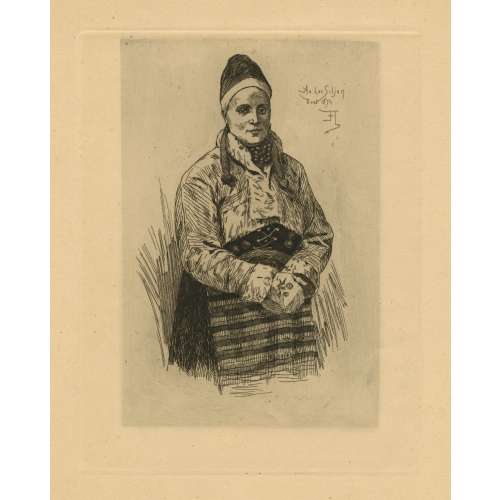
Etching on laid paper, monogrammed in the plate and inscribed "Au Lac Siljan, Août 1874". Owner's stamp LVM on verso.
Dimensions: Paper: 47 x 34 cm; Plate: 24 x 19 cm; Image: 21 x 14 cm.
Catalogue raisonné: Rouir 858:5; Arthur Hubschmid (1977): 320.
-
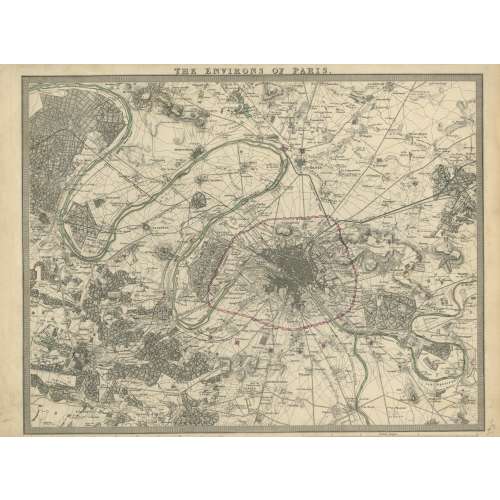 London: Published under the superintendence of the Society for the Diffusion of Useful Knowledge; Charles Knight & Co., no. 22 Ludgate Street. Dimensions: Sheet: 34 x 41.8 cm: Image: 28.7 x 38.3 cm. J. & C. Walker, Society for the Diffusion of Useful Knowledge Charles Knight & Co.; Charles Knight (British, 1791 – 1873) – publisher. J & C Walker (British firm, fl. 1820 – 1895) Walker, John (British, 1787 – 1873) Walker, Alexander (British, 1797? – 1870) Walker, Charles (British, 1799? – 1872) Society for the Diffusion of Useful Knowledge (SDUK) (British firm, 1826 – 1846)
London: Published under the superintendence of the Society for the Diffusion of Useful Knowledge; Charles Knight & Co., no. 22 Ludgate Street. Dimensions: Sheet: 34 x 41.8 cm: Image: 28.7 x 38.3 cm. J. & C. Walker, Society for the Diffusion of Useful Knowledge Charles Knight & Co.; Charles Knight (British, 1791 – 1873) – publisher. J & C Walker (British firm, fl. 1820 – 1895) Walker, John (British, 1787 – 1873) Walker, Alexander (British, 1797? – 1870) Walker, Charles (British, 1799? – 1872) Society for the Diffusion of Useful Knowledge (SDUK) (British firm, 1826 – 1846) -
 Utagawa Kunisada [歌川 国貞]; a.k.a. Utagawa Toyokuni III [三代歌川豊国] (Japanese, 1786 – 1865). Signed: Toyokuni ga [豊国 画] in a yellow toshidama cartouche. Publisher: Unknown, seal [久] Kyū (Japanese, fl. c. 1851 – 1861); (Marks 07-023 | U176a, possibly Sagamia Kyūzō). Date seal and double nanushi censor seals: Fuku & Muramatsu, Kaei 6, 2nd month (2/1853). Inscription in a red cartouche: (Purple of Edo // Purple of the Bay Capital) [江都むらさき] (Edo Murasaki), alluding to Murasaki Shikibu [紫 式部] (Japanese, c. 973/8 – c. 1014/31), the author of Genji Monogatari [源氏物語] (The Tale of Genji), a Heian period novel which was the source of a parody Nise Murasaki Inaka Genji [偐紫田舎源氏] (Fake Murasaki’s Rustic Genji) by Ryutei Tanehiko [柳亭種彦] (Japanese, 1783 – 1842). According to Horst Graebner: The actor is most probably Onoe Baikō IV [四代目尾上菊五郞] Onoe Kikugorō IV [四代目 尾上菊五郎] (Japanese, 1808 – 1860); other names: Onoe Baikō IV, Onoe Eizaburō III, Onoe Kikue, Nakamura Tatsuzō, Nakamura Kachō. One of the series of Kunisada's fan prints in this collection:
Utagawa Kunisada [歌川 国貞]; a.k.a. Utagawa Toyokuni III [三代歌川豊国] (Japanese, 1786 – 1865). Signed: Toyokuni ga [豊国 画] in a yellow toshidama cartouche. Publisher: Unknown, seal [久] Kyū (Japanese, fl. c. 1851 – 1861); (Marks 07-023 | U176a, possibly Sagamia Kyūzō). Date seal and double nanushi censor seals: Fuku & Muramatsu, Kaei 6, 2nd month (2/1853). Inscription in a red cartouche: (Purple of Edo // Purple of the Bay Capital) [江都むらさき] (Edo Murasaki), alluding to Murasaki Shikibu [紫 式部] (Japanese, c. 973/8 – c. 1014/31), the author of Genji Monogatari [源氏物語] (The Tale of Genji), a Heian period novel which was the source of a parody Nise Murasaki Inaka Genji [偐紫田舎源氏] (Fake Murasaki’s Rustic Genji) by Ryutei Tanehiko [柳亭種彦] (Japanese, 1783 – 1842). According to Horst Graebner: The actor is most probably Onoe Baikō IV [四代目尾上菊五郞] Onoe Kikugorō IV [四代目 尾上菊五郎] (Japanese, 1808 – 1860); other names: Onoe Baikō IV, Onoe Eizaburō III, Onoe Kikue, Nakamura Tatsuzō, Nakamura Kachō. One of the series of Kunisada's fan prints in this collection: -
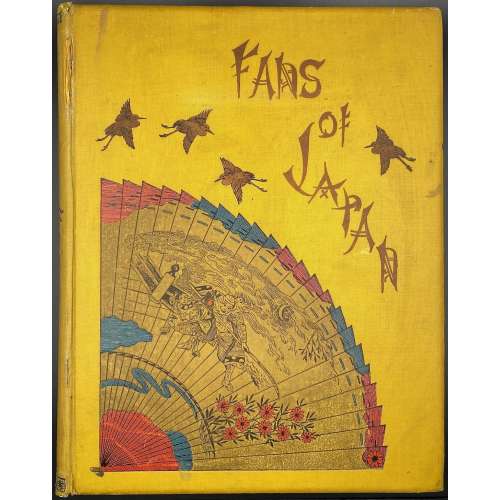 Description: Hardcover, 31.5 x 25 cm, yellow cloth adorned with stylized lettering and coloured design elements, blue endpapers, all margins red; Errata slip tipped in p.1. Lacks dust jacket. Inset: newspaper clipping titled "Facsimile of the fan distributed after the Tien-Tsin Massacre". Title-page: Fans of Japan | BY | CHARLOTTE M. SALWEY | née BIRCH | WITH INTRODUCTION BY | WILLIAM ANDERSON, F.R.C.S. | LATE OF H. M’S. LEGATION, JAPAN | AND | WITH TEN FULL-PAGE COLOURED PLATES, AND THIRTY-NINE | ILLUSTRATIONS IN BLACK AND WHITE | {publisher’s device} | LONDON | KEGAN PAUL, TRENCH, TRÜBNER & CO. LTD | PATERNOSTER HOUSE, CHARRING CROSS ROAD | 1894 || Pagination: [i-vi] vii-xix [xx] [1] 2-148 [4]; total 172 pages. Collation: 4to; π10 A-T4 (total 86 leaves) plus 10 colour plates with tissue guards and 39 b/w in-text illustrations. Plate I pasted in a kind of matt, though with red margins as all other pages. Printer: Ballantyne, Hanson and Co. Chromo-lithographer: McLagan and Cumming (Edinburgh) Publisher: Kegan Paul, Trench, Trübner & Co. Charles Kegan Paul (British, 1828 – 1902) – publisher. Author: Charlotte Maria Salwey [née Birch] (British, b. 1847 – after 1919). Introduction: William Anderson (British, 1842 – 1900) Dedicatee: Dr. Samuel Birch (British, 1813 – 1885)
Description: Hardcover, 31.5 x 25 cm, yellow cloth adorned with stylized lettering and coloured design elements, blue endpapers, all margins red; Errata slip tipped in p.1. Lacks dust jacket. Inset: newspaper clipping titled "Facsimile of the fan distributed after the Tien-Tsin Massacre". Title-page: Fans of Japan | BY | CHARLOTTE M. SALWEY | née BIRCH | WITH INTRODUCTION BY | WILLIAM ANDERSON, F.R.C.S. | LATE OF H. M’S. LEGATION, JAPAN | AND | WITH TEN FULL-PAGE COLOURED PLATES, AND THIRTY-NINE | ILLUSTRATIONS IN BLACK AND WHITE | {publisher’s device} | LONDON | KEGAN PAUL, TRENCH, TRÜBNER & CO. LTD | PATERNOSTER HOUSE, CHARRING CROSS ROAD | 1894 || Pagination: [i-vi] vii-xix [xx] [1] 2-148 [4]; total 172 pages. Collation: 4to; π10 A-T4 (total 86 leaves) plus 10 colour plates with tissue guards and 39 b/w in-text illustrations. Plate I pasted in a kind of matt, though with red margins as all other pages. Printer: Ballantyne, Hanson and Co. Chromo-lithographer: McLagan and Cumming (Edinburgh) Publisher: Kegan Paul, Trench, Trübner & Co. Charles Kegan Paul (British, 1828 – 1902) – publisher. Author: Charlotte Maria Salwey [née Birch] (British, b. 1847 – after 1919). Introduction: William Anderson (British, 1842 – 1900) Dedicatee: Dr. Samuel Birch (British, 1813 – 1885) -
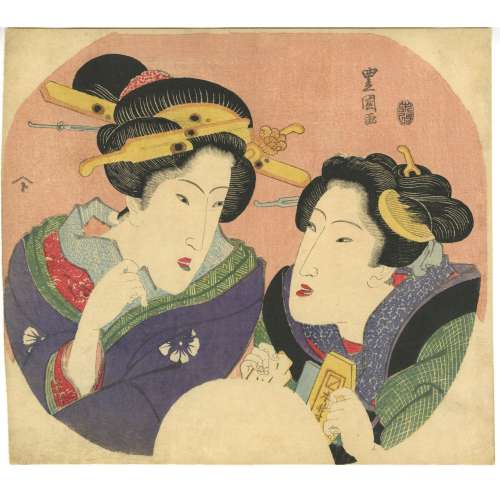 Artist: Utagawa Toyokuni I [歌川豊国] (1769–1825). Pubisher: Enshūya Matabei (遠州屋又兵衛) (c. 1768 – 1881), seal name: Enmata [ 遠又]. Signed: Toyokuni ga [豊国画]. Date-aratame censor seal: 未改, Bunsei 6 (1823). Size: uchiwa-e; 233 x 262 mm. Ref: Israel Goldman. Japanese Prints, Paintings and Books / Catalogue 28, 2022: № 14.
Artist: Utagawa Toyokuni I [歌川豊国] (1769–1825). Pubisher: Enshūya Matabei (遠州屋又兵衛) (c. 1768 – 1881), seal name: Enmata [ 遠又]. Signed: Toyokuni ga [豊国画]. Date-aratame censor seal: 未改, Bunsei 6 (1823). Size: uchiwa-e; 233 x 262 mm. Ref: Israel Goldman. Japanese Prints, Paintings and Books / Catalogue 28, 2022: № 14. -
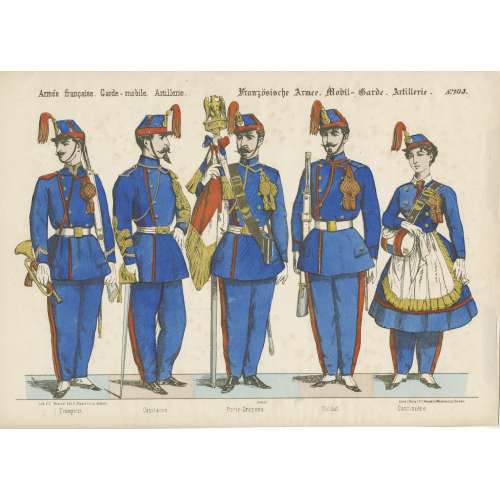 Hand-coloured woodcut on wove paper, 282 x 392 mm; black ink stamp “5051 2” to reverse. Top: "Armée française. Garde–mobile. Artillerie." — (gothic font) "Französische Armee. Mobil–Garde. Artillerie." — "№103". Below left: "Lith F. C. Wentzel édit. à Wissembourg. (Alsacé); center: Déposé; right: Druck u. Verlag v. F. C. Wentzel in Weissemburg. (Elsass)."; Bottom: "Trompette" — "Capitaine" — "Porte-Drapeau". — "Soldat" — "Cantinière." Jean Frédéric Wentzel (French, 1807 – 1869) – publisher/printer.
Hand-coloured woodcut on wove paper, 282 x 392 mm; black ink stamp “5051 2” to reverse. Top: "Armée française. Garde–mobile. Artillerie." — (gothic font) "Französische Armee. Mobil–Garde. Artillerie." — "№103". Below left: "Lith F. C. Wentzel édit. à Wissembourg. (Alsacé); center: Déposé; right: Druck u. Verlag v. F. C. Wentzel in Weissemburg. (Elsass)."; Bottom: "Trompette" — "Capitaine" — "Porte-Drapeau". — "Soldat" — "Cantinière." Jean Frédéric Wentzel (French, 1807 – 1869) – publisher/printer. -
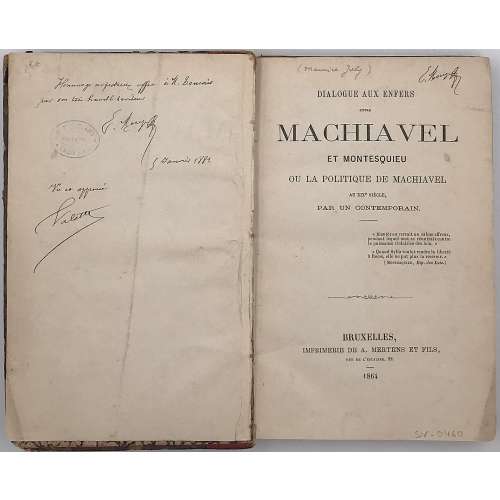 Title page: DIALOGUE AUX ENFERS | ENTRE | MACHIAVEL | ET MONTESQUIEU | OU LA POLITIQUE DE MACHIAVEL | AU XIXe SIÈCLE, | PAR UN CONTEMPORAIN. | {6 lines of citations} | ~ | BRUXELLES, | IMPRIMERIE DE A. MERTENS ET FILS, | RUE DE L’ESCALIER, 22. | 1864 ||
Title page: DIALOGUE AUX ENFERS | ENTRE | MACHIAVEL | ET MONTESQUIEU | OU LA POLITIQUE DE MACHIAVEL | AU XIXe SIÈCLE, | PAR UN CONTEMPORAIN. | {6 lines of citations} | ~ | BRUXELLES, | IMPRIMERIE DE A. MERTENS ET FILS, | RUE DE L’ESCALIER, 22. | 1864 ||Description: 17.9 x 12 cm, quarter red morocco over marbled boards, spine with raised bands, gilt bees in compartments, gilt lettering, marbled endpapers, ffep cut out top 1/4, ffep and h.t. loose.
Collation: 12mo; fep, π4 1-2712, 292, fep.; total 174 leaves. Pagination: [2 h.t] [2 t.p.] [i] ii-iii [iv] [1] 2-337 [338] [2 errata].Inscriptions and markings: "Hommage respectueux offert à M. Bourdais par son très humble serviteur, 5 Janvier 1881". Signature: E. Rouger (?) "Vu et approuvé". "Valatte". Ink stamp: "M<aîtr>e E. Brouard - Notaire a Laon Aisne".
Other copies: LIB-1034.2016 and LIB-2913.2021. Other related objects: SVVP-0062.2021. The publication was funded by the author and smuggled into France. Contributors: Maurice Joly (French, 1829 – 1878) -
 Artist: Utagawa Toyokuni I [歌川豊国] (1769–1825). Title: 「しなのやおこん 瀬川菊之丞」「帯屋長右衛門 嵐雛助」 Kabuki play: Katsuragawa Renri no Shigarami [桂川連理柵]. According to Waseda University Cultural Resource Database, the play was performed at Ichimura-za (Edo) on the 2nd month of Kansei 12 (year 1800) under the title 楼門五山桐 さんもんごさんのきり. Publisher: Nishimuraya Yohachi [西村屋与八] (Japanese, c. 1751 – 1869)., Play by Suga Sensuke [菅専助] (ca. 1728 – 1791) in two acts. First performed at Kita Horie-za in Osaka in October 1776. Based on a real incident occurring sometime in the Kyōhō era (1716-35), this story was first dramatized in 1761. The first Kabuki drama to stem from this play was in 1777 at Osaka's Araki-za. Obiya Chōemon, a married obi merchant (sitting with abacus) in his forties, meets his neighbour's daughter Ohan (standing behind Obiya), who is young enough to be his daughter, at an inn in Ishibe; the two fall in love and pledged their troth. Ohan becomes pregnant. After a series of misfortunes, the lovers rush to Katsuragawa (Katsura River), where they drown themselves.
Artist: Utagawa Toyokuni I [歌川豊国] (1769–1825). Title: 「しなのやおこん 瀬川菊之丞」「帯屋長右衛門 嵐雛助」 Kabuki play: Katsuragawa Renri no Shigarami [桂川連理柵]. According to Waseda University Cultural Resource Database, the play was performed at Ichimura-za (Edo) on the 2nd month of Kansei 12 (year 1800) under the title 楼門五山桐 さんもんごさんのきり. Publisher: Nishimuraya Yohachi [西村屋与八] (Japanese, c. 1751 – 1869)., Play by Suga Sensuke [菅専助] (ca. 1728 – 1791) in two acts. First performed at Kita Horie-za in Osaka in October 1776. Based on a real incident occurring sometime in the Kyōhō era (1716-35), this story was first dramatized in 1761. The first Kabuki drama to stem from this play was in 1777 at Osaka's Araki-za. Obiya Chōemon, a married obi merchant (sitting with abacus) in his forties, meets his neighbour's daughter Ohan (standing behind Obiya), who is young enough to be his daughter, at an inn in Ishibe; the two fall in love and pledged their troth. Ohan becomes pregnant. After a series of misfortunes, the lovers rush to Katsuragawa (Katsura River), where they drown themselves.Segawa Kikunojō III (Japanese, 1751 – 1810); other names: Segawa Senjo, Segawa Rokō III, Segawa Tomisaburō I, Ichiyama Tomisaburō, Ichiyama Shichinosuke. The actor held the name of Segawa Kikunojō III from the 11th lunar month of 1774 to the 7th lunar month of 1801. He surpassed all the actors of his time in both female and male roles, especially in the former, and achieved tremendous public acclaim.
Arashi Hinasuke II [嵐雛助] (Japanese, c. 1774 – 1801); other names: Nakamura Jūzō III, Kanō Hidenosuke I, Arashi Hidenosuke I. The actor held the name of Arashi Hinasuke II from the 1st lunar month of 1794 to the 2nd lunar month of 1801. Hi died in Edo on the 4th day of the 2nd lunar month of 1801. For the same characters illustrated by Utagawa Kuniyoshi see SVJP-0333.2021. Sources:
Sources:
- Historical Dictionary of Japanese Traditional Theatre By Samuel L. Leiter. Second edition, 2014.
- Kabuki Encyclopedia. An English-Langauge Adaptation of Kabuki Jiten. Samuel L. Leiter. Greenwood Press, 1979.
- http://www.kabuki21.com/
- Waseda University Cultural Resource Database
-

Thin six-lobed iron plate of brownish color is carved on each side with a groove that follows the rim and a concentric grooves around the center of the plate, also carved with six thin scroll lines (mokkō or handles, kan) that follow the shape of the rim. Mokume surface treatment. Hitsu-ana possibly added at a later date, and kogai-hitsu-ana plugged with gold. Silver sekigane.
Signed: Kunihide [國秀]. Higo school, 1st generation swordsmith.
Mid Edo period, ca. 1800.
Would be possibly attributed to Kamakura-bori school revival of the 19th century.
References: Nihon Tō Kōza, Volume VI / Japanese Sword / Kodōgu Part 1, page 231: Enju Kunihide, a tōshō from Higo: "...forging of the jigane is excellent, and there are also pieces with mokume hada."
Haynes Index Vol. 1, p. 741, H 03569.0: "Enju Kunihide in Higo province, died 1830, student of Suishinshi Masahide. Retainer of the Hosokawa Daimyō, etc."
Additional Information from Markus Sesko: This tsuba indeed is made by Enju Kunihide, who in his later years signed the HIDE [秀] character as HI [日] and DE [出], as here: Size: 77.4 x 74.9 x 2.7 mm
Similar pieces are:
1. In this collection № TSU-0341: Kamakura-bori tsuba with mokkō motif. Muromachi period, 15th - 16th century.
2. Dr. Walter A. Compton Collection, 1992, Christie’s auction, Part II, pp. 14-15, №16: “A kamakurabori type tsuba, Muromachi period, circa 1400. The thin, six-lobed iron plate is carved on each side with a wide groove that follows the shape of the rim, and with six scroll lines and a single thin circular groove. […] The hitsu-ana was added at a later date, circa 1500-1550. Height 8.3 cm, width 8.6 cm, thickness 2.5 mm. The tsuba was initially intended to be mounted on a tachi of the battle type in use from Nambokucho to early Muromachi period (1333-1400)”. Sold at $935.
Size: 77.4 x 74.9 x 2.7 mm
Similar pieces are:
1. In this collection № TSU-0341: Kamakura-bori tsuba with mokkō motif. Muromachi period, 15th - 16th century.
2. Dr. Walter A. Compton Collection, 1992, Christie’s auction, Part II, pp. 14-15, №16: “A kamakurabori type tsuba, Muromachi period, circa 1400. The thin, six-lobed iron plate is carved on each side with a wide groove that follows the shape of the rim, and with six scroll lines and a single thin circular groove. […] The hitsu-ana was added at a later date, circa 1500-1550. Height 8.3 cm, width 8.6 cm, thickness 2.5 mm. The tsuba was initially intended to be mounted on a tachi of the battle type in use from Nambokucho to early Muromachi period (1333-1400)”. Sold at $935.
 3. And another one in Robert E. Haynes Catalog #9 on page 24-25 under №23: “Typical later Kamakura-bori style work. This type of plate and carving show the uniform work produced by several schools in the Muromachi </em period. Some had brass inlay and others were just carved as this one is. The hitsu are later. Ca. 1550. Ht. 8.8 cm, Th. 3.25 mm”. Sold for $175.
3. And another one in Robert E. Haynes Catalog #9 on page 24-25 under №23: “Typical later Kamakura-bori style work. This type of plate and carving show the uniform work produced by several schools in the Muromachi </em period. Some had brass inlay and others were just carved as this one is. The hitsu are later. Ca. 1550. Ht. 8.8 cm, Th. 3.25 mm”. Sold for $175.

-
 Artist: Utagawa Kuniyoshi [歌川 國芳] (Japanese, 1798 – 1861). Publisher: Ibaya Senzaburō [伊場屋仙三郎] (Japanese, c. 1815 – 1869). Published in c. 1845 (no seal). Possibly, from the "Untitled series of beauties reflected in mirrors", see Kunisada Project. However, this print does not have the seal of the censor Tanaka [田中].
Artist: Utagawa Kuniyoshi [歌川 國芳] (Japanese, 1798 – 1861). Publisher: Ibaya Senzaburō [伊場屋仙三郎] (Japanese, c. 1815 – 1869). Published in c. 1845 (no seal). Possibly, from the "Untitled series of beauties reflected in mirrors", see Kunisada Project. However, this print does not have the seal of the censor Tanaka [田中]. -
![Charles Virmaître. Paris-Canard. – Paris: Albert Savine, 1888. – pp.: ffl [2 blanks] [2 orig. yellow cover, verso blank] [2 - ht, advert.] [2 - t.p., blank] 1-319 [320 blank] [2 back orig. cover, recto blank]. [Autograph].](https://varshavskycollection.com/wp-content/uploads/2021/02/LIB-2535.2020-c-500x500.jpeg) Cover: (original wrapper) PARIS-CANARD| PAR | CH. VIRMAITRE | A. SAVINE, Édeiteur, rue Drouot, 18, PARIS || Wood engraving to cover signed LeNatur — Michelet, sc. Title page: CHARLES VIRMAITRE | PARIS–CANARD | {publisher’s device} | PARIS | NOUVELLE LIBRAIRIE PARISIENNE | ALBERT SAVINE, ÉDITEUR | 18, RUE DROUOT, 18 | 1888 | Tous droits réservés. || Pagination: 2 blank leaves, original pictorial wrapper, [4], [1] 2-319 [320 blank], original back wrapper with publisher’s advertisement, 2 blank leaves. Collation: 12mo; π2, 1-1712 184. Binding: 18 x 12 cm, hardcover; quarter blue percaline, marbled boards, red title label ruled gilt with gilt lettering, gilt double tail ruler, fleuron to spine; original paper wrappers preserved. Bookplate to front pastedown: "EX LIBRIS EUGENE SELIGMANN" written on a ribbon; ink inscription to half-title in french: "To my good friends Paul Vogler and Maurice Radiguet, former – for a new acquaintance, latter – to become great." Signed: Ch. Virmaitre. Paul Vogler (French, 1853 – 1904) – painter in the Impressionist style. Jules Maurice Radiguet (French, 1866 – 1941) – illustrator , caricaturist and cartoonist. Father of Raymond Radiguet (French, 1903 – 1923).
Cover: (original wrapper) PARIS-CANARD| PAR | CH. VIRMAITRE | A. SAVINE, Édeiteur, rue Drouot, 18, PARIS || Wood engraving to cover signed LeNatur — Michelet, sc. Title page: CHARLES VIRMAITRE | PARIS–CANARD | {publisher’s device} | PARIS | NOUVELLE LIBRAIRIE PARISIENNE | ALBERT SAVINE, ÉDITEUR | 18, RUE DROUOT, 18 | 1888 | Tous droits réservés. || Pagination: 2 blank leaves, original pictorial wrapper, [4], [1] 2-319 [320 blank], original back wrapper with publisher’s advertisement, 2 blank leaves. Collation: 12mo; π2, 1-1712 184. Binding: 18 x 12 cm, hardcover; quarter blue percaline, marbled boards, red title label ruled gilt with gilt lettering, gilt double tail ruler, fleuron to spine; original paper wrappers preserved. Bookplate to front pastedown: "EX LIBRIS EUGENE SELIGMANN" written on a ribbon; ink inscription to half-title in french: "To my good friends Paul Vogler and Maurice Radiguet, former – for a new acquaintance, latter – to become great." Signed: Ch. Virmaitre. Paul Vogler (French, 1853 – 1904) – painter in the Impressionist style. Jules Maurice Radiguet (French, 1866 – 1941) – illustrator , caricaturist and cartoonist. Father of Raymond Radiguet (French, 1903 – 1923). -
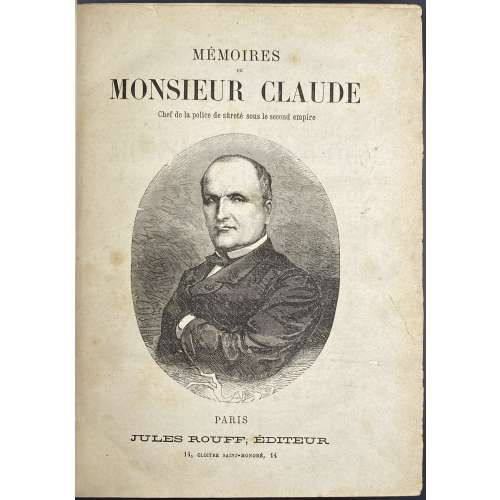 Vol. 1: Title: MÉMOIRES | DE | MONSIEUR CLAUDE | CHEF DE LA POLICE DE SURETÉ́ SOUS LE SECOND EMPIRE | {single rule} | PREMIER VOLUME | publisher’s device «JR» in oval} | PARIS | JULES ROUFF ET Cie, ÉDITEURS | 14, CLOITRE SAINT-HONORÉ, 14 | {single rule} || Pagination: [4] – h.t., t.p., [1-3] – engraved t.p. w/portrait, 3-800 [4], in-text and full-page woodcuts; last two leaves (table) has numbered pages 1000 and 1001; the total number of pages 808. Collation: 4to; π2 [1]4 2-1004 Ω2, woodcuts by Quesnel and Ferdinandus, within collation; the total number of leaves 404. Vol. 2: Title: Same but “DEUXIEME VOLUME” Pagination: [4] – h.t., t.p., [801-2] – frontis., 803-2010, [6] – assassinats, [4] – table, in-text and full-page woodcuts; last two leaves (table) has numbered pages 2018 and 2019; the total number of pages 1224. Collation: 4to; π2 101-2524 Ω2, woodcuts by Quesnel and Ferdinandus, within collation; the total number of leaves 612. Binding: Two volumes 28 x 20.5 cm each, uniformly bound in quarter polished brown calf over marbled boards, blind-stamped florets and gilt lettering to spine, marbled endpapers. Contributors: Claude, Antoine (French, 1807 – 1880) – declared author of the text. Labourieu, Théodore (French, 1822 – 1889) – assumed author of the text. Quesnel, Désiré Mathieu (French, 1843 – 1915) – woodcut printmaker. Ferdinandus, Alexandre [Avenet, François] (French, 1850 – 1888) – illustrator. D. Bardin et Cie – printer. Jules Rouff (French, 1846 – 1927) – publisher. Jules Rouff et Cie (Paris, 1873 – 1982) – publisher. Note: Common opinion is that the text was produced by Théodore Labourieu, not by, Antoine Claude. The first edition was published by the same publisher in 10 volumes in wrappers without illustrations, between 1880 and 1883, after the death of Antoine Claude. As stated in WorldCat: “not written or sanctioned by him.” This two-volume edition was published later, with multiple woodcuts.
Vol. 1: Title: MÉMOIRES | DE | MONSIEUR CLAUDE | CHEF DE LA POLICE DE SURETÉ́ SOUS LE SECOND EMPIRE | {single rule} | PREMIER VOLUME | publisher’s device «JR» in oval} | PARIS | JULES ROUFF ET Cie, ÉDITEURS | 14, CLOITRE SAINT-HONORÉ, 14 | {single rule} || Pagination: [4] – h.t., t.p., [1-3] – engraved t.p. w/portrait, 3-800 [4], in-text and full-page woodcuts; last two leaves (table) has numbered pages 1000 and 1001; the total number of pages 808. Collation: 4to; π2 [1]4 2-1004 Ω2, woodcuts by Quesnel and Ferdinandus, within collation; the total number of leaves 404. Vol. 2: Title: Same but “DEUXIEME VOLUME” Pagination: [4] – h.t., t.p., [801-2] – frontis., 803-2010, [6] – assassinats, [4] – table, in-text and full-page woodcuts; last two leaves (table) has numbered pages 2018 and 2019; the total number of pages 1224. Collation: 4to; π2 101-2524 Ω2, woodcuts by Quesnel and Ferdinandus, within collation; the total number of leaves 612. Binding: Two volumes 28 x 20.5 cm each, uniformly bound in quarter polished brown calf over marbled boards, blind-stamped florets and gilt lettering to spine, marbled endpapers. Contributors: Claude, Antoine (French, 1807 – 1880) – declared author of the text. Labourieu, Théodore (French, 1822 – 1889) – assumed author of the text. Quesnel, Désiré Mathieu (French, 1843 – 1915) – woodcut printmaker. Ferdinandus, Alexandre [Avenet, François] (French, 1850 – 1888) – illustrator. D. Bardin et Cie – printer. Jules Rouff (French, 1846 – 1927) – publisher. Jules Rouff et Cie (Paris, 1873 – 1982) – publisher. Note: Common opinion is that the text was produced by Théodore Labourieu, not by, Antoine Claude. The first edition was published by the same publisher in 10 volumes in wrappers without illustrations, between 1880 and 1883, after the death of Antoine Claude. As stated in WorldCat: “not written or sanctioned by him.” This two-volume edition was published later, with multiple woodcuts. -
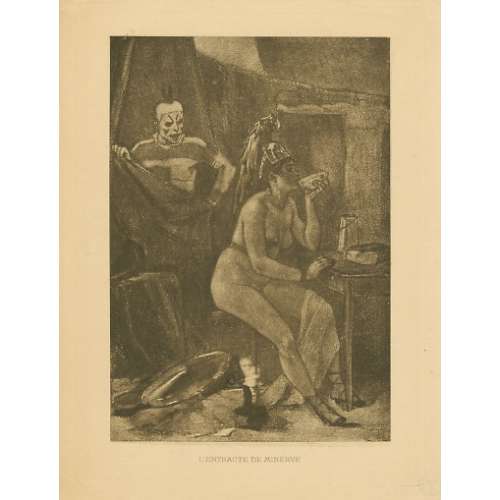
Photogravure after a pastel drawing by F. Rops. Monogrammed in the plate 'FR'. Owner's stamp 'LvM' on verso.
Dimensions: Paper: 26 x 20 cm; Plate: 25 x 18 cm; Image: 21 x 14.5 cm.
Catalogue raisonné: Arthur Hubschmid (1977): 543; Graphics irreverent and erotic (1968): 156.







